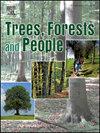Detecting oil palm plantations and mangroves overlooked by IGBP land-cover products with “ground-truthing from the sky” across Southeast Asia
IF 2.9
Q1 FORESTRY
引用次数: 0
Abstract
Tropical deforestation in Southeast (SE) Asia is largely driven by expansion of oil palm plantations, which are difficult to detect with global- or regional-scale remote-sensing products. This paper demonstrates a straight-forward method for “ground-truthing from the sky” with very high resolution (VHR) photographic images to detect oil-palm cultivation and other drivers of deforestation across SE Asia. The MCD12Q1 land-cover is a widely used land-cover product that generates annual 500 m-pixel maps of 17 IGBP (International Geosphere-Biosphere Programme) classes. While this resolution is practical for regional assessments across SE Asia (∼4.5 million km2), it is too coarse to identify fine-scale, agriculture-driven conversions such as oil-palm expansion. Our approach was to integrate MCD12Q1 data with VHR imagery from Google Earth by random subsampling within each major land cover type to which forests had transitioned during two periods (2001–2010 and 2010–2018). Each of the 260 verification points in each post-transition land type was visually interpreted, from which we generated correction factors to calibrate land-use change probabilities. Whereas uncalibrated results showed that 12 % and 9 % of forested areas were converted to woody savanna and savanna, VHR-images showed that 32 % to 46 % of them were oil palm plantations. After application of these correction factors, we estimated that 40 % and 48 % of forest losses were due to oil palm expansion, whereas the remaining forest loss was attributed to degradation to savannas and grasslands. Additionally, permanent wetland classified by MCD12Q1 was found to consist of mangroves (63 %), aqua farms (20 %), and oil palms (8 %) rather than lakes, rivers and marshes in the region. While MODIS remains a valuable source for analyzing land use changes across large areas, detection of deforestation driven by agricultural activities benefits from calibration with VHR imagery. Our approach is straightforward and requires minimal expertise, making it easily adoptable by local governments, NGOs, land managers and others.
通过“来自天空的地面真相”探测被IGBP土地覆盖产品忽视的油棕种植园和红树林,覆盖整个东南亚
东南亚的热带森林砍伐主要是由油棕种植园的扩张驱动的,而油棕种植园的扩张是难以用全球或区域尺度的遥感产品检测到的。本文展示了一种直接的方法,利用超高分辨率(VHR)摄影图像“从天空中获取地面真相”,以检测东南亚油棕种植和其他森林砍伐的驱动因素。MCD12Q1土地覆盖是一个广泛使用的土地覆盖产品,每年生成17个IGBP(国际地圈-生物圈计划)类别的5亿像素地图。虽然这一分辨率对于整个东南亚(约450万平方公里)的区域评估是实用的,但它过于粗糙,无法确定油棕扩张等小规模农业驱动的转换。我们的方法是在两个时期(2001-2010年和2010-2018年),通过随机抽样,将MCD12Q1数据与谷歌地球的VHR图像整合在一起,其中森林已经过渡到每个主要的土地覆盖类型。每种过渡后土地类型的260个验证点中的每一个都进行了可视化解释,我们从中生成校正因子来校准土地利用变化概率。未经校准的结果显示,12%和9%的森林面积被转化为木质稀树草原和稀树草原,而vhr图像显示,其中32%至46%是油棕种植园。在应用这些校正因子后,我们估计40%和48%的森林损失是由于油棕的扩张,而其余的森林损失归因于稀树草原和草原的退化。此外,MCD12Q1分类的永久湿地由红树林(63%)、水产养殖场(20%)和油棕(8%)组成,而不是该地区的湖泊、河流和沼泽。虽然MODIS仍然是分析大面积土地利用变化的宝贵来源,但探测由农业活动驱动的森林砍伐也受益于VHR图像的校准。我们的方法很简单,只需要很少的专业知识,很容易被地方政府、非政府组织、土地管理者和其他人采用。
本文章由计算机程序翻译,如有差异,请以英文原文为准。
求助全文
约1分钟内获得全文
求助全文
来源期刊

Trees, Forests and People
Economics, Econometrics and Finance-Economics, Econometrics and Finance (miscellaneous)
CiteScore
4.30
自引率
7.40%
发文量
172
审稿时长
56 days
 求助内容:
求助内容: 应助结果提醒方式:
应助结果提醒方式:


